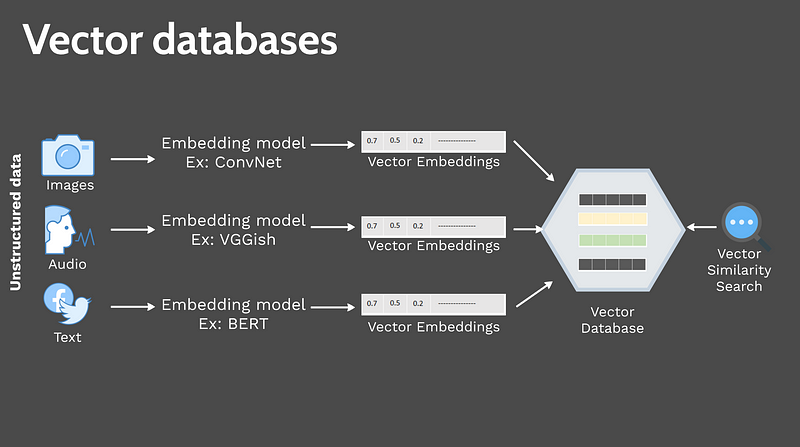In the vast landscape of data science, vector databases have emerged as a powerful tool for storing and leveraging vector embeddings. These databases enable the storage of vector representations for various types of data, such as text, audio, images, and even videos. In this blog post, we'll delve into the world of vector databases, understanding the concept of vector embeddings and the invaluable role these databases play in facilitating vector similarity searches. Unlike traditional structured data storage or unstructured data repositories, vector databases specialize in high-dimensional numerical representations. Join us on this exciting journey as we explore the potential of vector databases and their applications in diverse industries.

Understanding Vector Embeddings
To comprehend vector databases, it's essential to grasp the concept of vector embeddings. Put simply, a vector is a numerical representation that captures the meaning and relationships between different items. As data scientists, you might already be familiar with Word2Vec, a neural network model that learns vector representations for words based on their contextual usage in large text corpora. These vector embeddings have revolutionized natural language processing tasks such as sentiment analysis, machine translation, and text classification. Modern implementations often store these embeddings in data lakes for batch processing or feature stores for real-time serving.
Expanding to Other Data Types
Vector databases go beyond text embeddings, encompassing various neural network models specialized in creating embeddings for different data types. For instance, ConvNet is extensively employed to generate vector embeddings for images, while VGG-ish is designed for audio embeddings. Additionally, Bert has gained popularity for creating text embeddings, offering enhanced contextual understanding. These diverse data types, including semi-structured data from sensors and APIs, can all be transformed into vector representations for similarity search.
Unleashing the Power of Vector Similarity Search:
Once the content is vectorized, vector databases enable us to perform vector similarity searches. This entails comparing the similarity between vectors using various techniques, such as cosine similarity, which measures the angle between vectors to determine their similarity. It's important to note that most text embeddings typically span hundreds of dimensions, providing a rich representation of semantic content beyond mere two-dimensional comparisons. These capabilities are particularly powerful when integrated with streaming data architectures for real-time similarity matching.
Applications and Benefits

Vector similarity search holds immense potential across diverse industries. In the realm of e-commerce, it enables online retailers to suggest visually similar products to customers by finding similarities in image embeddings. Imagine effortlessly discovering visually analogous products based on the power of vectors. Likewise, vector similarity search finds applications in natural language processing, allowing us to identify similar documents, sentences, or words based on their semantic content. These applications often integrate with feature stores to serve pre-computed embeddings and with data lakehouses for unified analytics across vector and traditional data.
In fields like security and law enforcement, vector similarity search contributes to fingerprint recognition and facial recognition, enabling rapid and accurate identification of individuals. By leveraging the power of vectors, these applications enhance public safety and security. Modern implementations often use data mesh architectures to ensure domain-specific ownership of biometric data while maintaining data contracts for quality and privacy compliance.
Live Demo
Test out an application built on top of vector database to get a feel of how it can impact your business. This demo uses the built-in Vector Search capabilities of Redis Enterprise to show how unstructured data, such as images and text, can be used to create powerful search engines.
Conclusion
Vector databases have revolutionized the way we store and leverage vector embeddings, opening up a world of possibilities in data science and machine learning. By harnessing the power of vectors, we can perform efficient vector similarity searches, enabling applications such as visual product recommendations, semantic matching, and advanced recognition systems. As you embark on your data science journey, remember to embrace the power of vector databases and the transformative impact they can have on your projects. Stay curious, explore further, and let vector databases unleash the true potential of your data-driven endeavors. Consider how vector databases integrate with your broader data architecture, including data lakes for storage, feature stores for serving, streaming architectures for real-time processing, and data mesh patterns for scalable, domain-oriented data management.